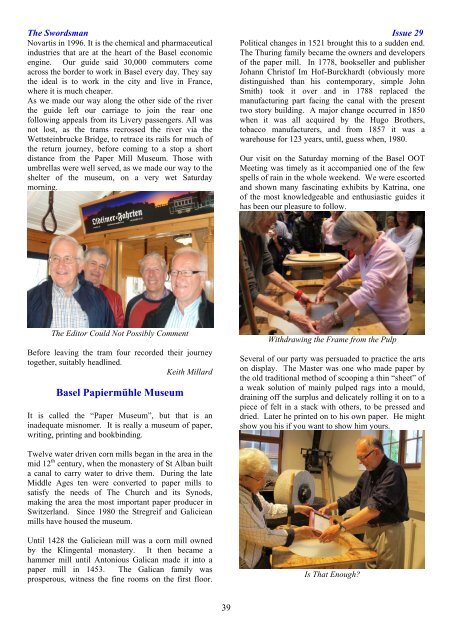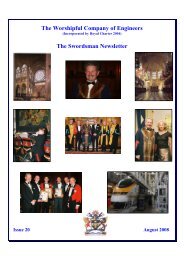The Worshipful Company of Engineers The Swordsman Newsletter ...
The Worshipful Company of Engineers The Swordsman Newsletter ...
The Worshipful Company of Engineers The Swordsman Newsletter ...
You also want an ePaper? Increase the reach of your titles
YUMPU automatically turns print PDFs into web optimized ePapers that Google loves.
<strong>The</strong> <strong>Swordsman</strong> Issue 29<br />
Novartis in 1996. It is the chemical and pharmaceutical<br />
industries that are at the heart <strong>of</strong> the Basel economic<br />
engine. Our guide said 30,000 commuters come<br />
across the border to work in Basel every day. <strong>The</strong>y say<br />
the ideal is to work in the city and live in France,<br />
where it is much cheaper.<br />
As we made our way along the other side <strong>of</strong> the river<br />
the guide left our carriage to join the rear one<br />
following appeals from its Livery passengers. All was<br />
not lost, as the trams recrossed the river via the<br />
Wettsteinbrucke Bridge, to retrace its rails for much <strong>of</strong><br />
the return journey, before coming to a stop a short<br />
distance from the Paper Mill Museum. Those with<br />
umbrellas were well served, as we made our way to the<br />
shelter <strong>of</strong> the museum, on a very wet Saturday<br />
morning.<br />
<strong>The</strong> Editor Could Not Possibly Comment<br />
Before leaving the tram four recorded their journey<br />
together, suitably headlined.<br />
Keith Millard<br />
Basel Papiermühle Museum<br />
It is called the “Paper Museum”, but that is an<br />
inadequate misnomer. It is really a museum <strong>of</strong> paper,<br />
writing, printing and bookbinding.<br />
Twelve water driven corn mills began in the area in the<br />
mid 12 th century, when the monastery <strong>of</strong> St Alban built<br />
a canal to carry water to drive them. During the late<br />
Middle Ages ten were converted to paper mills to<br />
satisfy the needs <strong>of</strong> <strong>The</strong> Church and its Synods,<br />
making the area the most important paper producer in<br />
Switzerland. Since 1980 the Stregreif and Galiciean<br />
mills have housed the museum.<br />
Until 1428 the Galiciean mill was a corn mill owned<br />
by the Klingental monastery. It then became a<br />
hammer mill until Antonious Galican made it into a<br />
paper mill in 1453. <strong>The</strong> Galican family was<br />
prosperous, witness the fine rooms on the first floor.<br />
39<br />
Political changes in 1521 brought this to a sudden end.<br />
<strong>The</strong> Thuring family became the owners and developers<br />
<strong>of</strong> the paper mill. In 1778, bookseller and publisher<br />
Johann Christ<strong>of</strong> Im H<strong>of</strong>-Burckhardt (obviously more<br />
distinguished than his contemporary, simple John<br />
Smith) took it over and in 1788 replaced the<br />
manufacturing part facing the canal with the present<br />
two story building. A major change occurred in 1850<br />
when it was all acquired by the Hugo Brothers,<br />
tobacco manufacturers, and from 1857 it was a<br />
warehouse for 123 years, until, guess when, 1980.<br />
Our visit on the Saturday morning <strong>of</strong> the Basel OOT<br />
Meeting was timely as it accompanied one <strong>of</strong> the few<br />
spells <strong>of</strong> rain in the whole weekend. We were escorted<br />
and shown many fascinating exhibits by Katrina, one<br />
<strong>of</strong> the most knowledgeable and enthusiastic guides it<br />
has been our pleasure to follow.<br />
Withdrawing the Frame from the Pulp<br />
Several <strong>of</strong> our party was persuaded to practice the arts<br />
on display. <strong>The</strong> Master was one who made paper by<br />
the old traditional method <strong>of</strong> scooping a thin “sheet” <strong>of</strong><br />
a weak solution <strong>of</strong> mainly pulped rags into a mould,<br />
draining <strong>of</strong>f the surplus and delicately rolling it on to a<br />
piece <strong>of</strong> felt in a stack with others, to be pressed and<br />
dried. Later he printed on to his own paper. He might<br />
show you his if you want to show him yours.<br />
Is That Enough?




